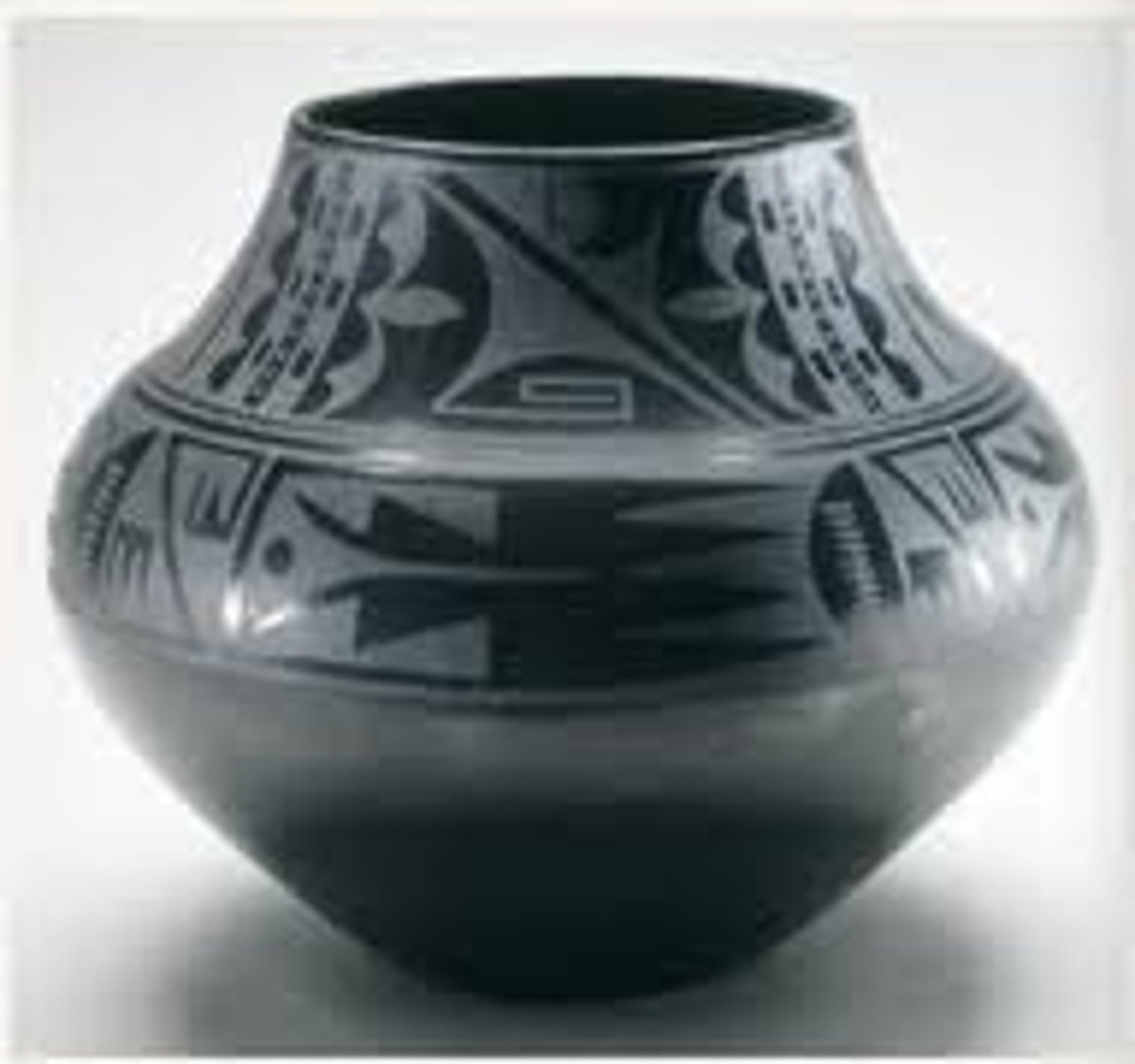Art of the Americas
1/26
There's no tags or description
Looks like no tags are added yet.
Name | Mastery | Learn | Test | Matching | Spaced |
|---|
No study sessions yet.
27 Terms
- religious capital
- 60 meters tall w/ jaguar sculpture (symbol of power)
- hidden entrance to temple led to stone corridors
- coordinated w/ adjacent river --> reference to water sources and their importance to society?
Chavín de Huántar
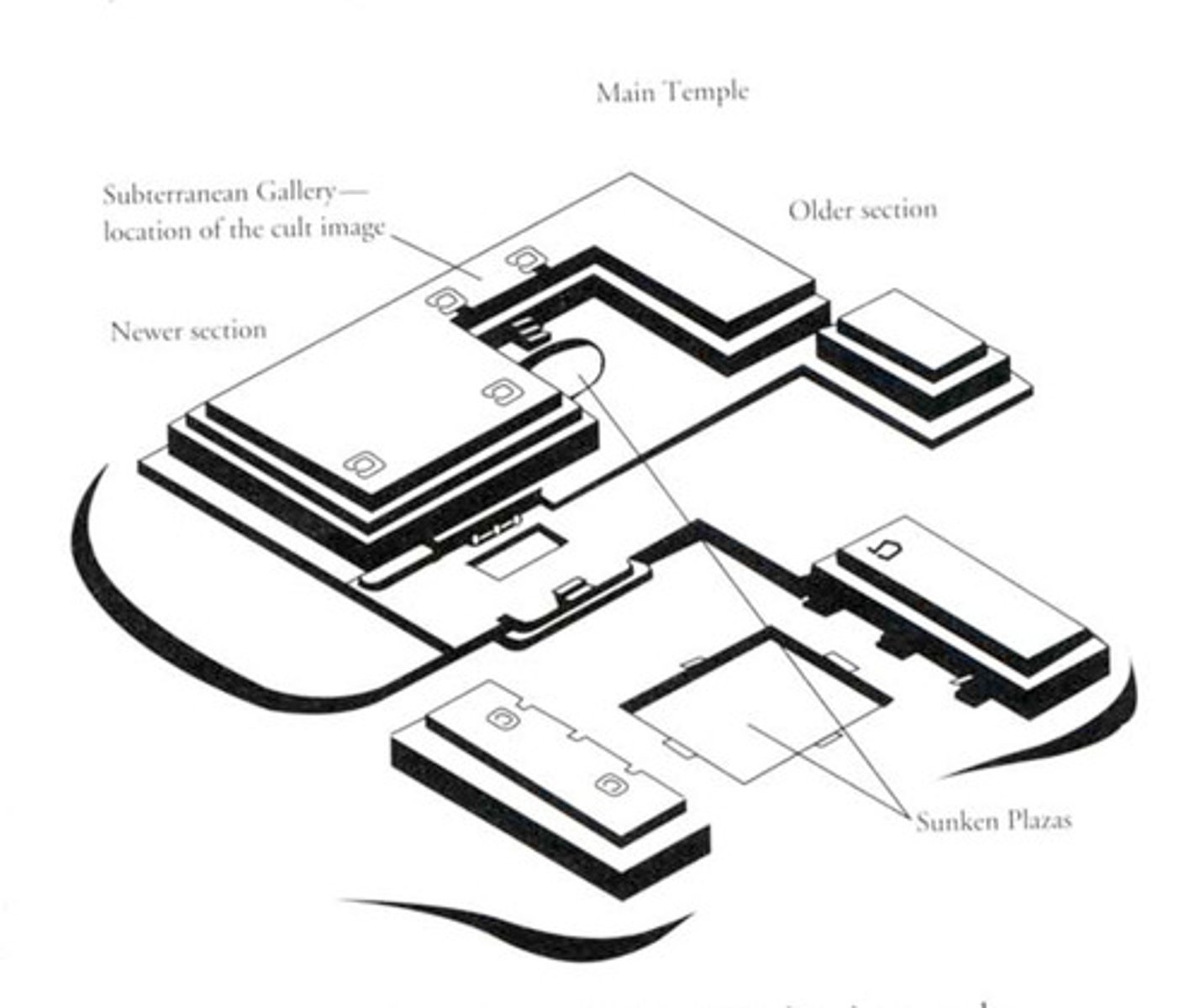
- inside Old Temple, maze-like system of hallways
- at center, underground, is Lanzon (Spanish for "blade") stone
- fifteen feet tall; blade shaped
- depicts powerful figure part human (body) and part animal (fangs, claws)
- head of snakes and face of jaguar
- eyebrows terminate in snakes
- flat relief; designs in curvilinear pattern
- served as cult figure
- center of pilgrimage; however, few had access to Lanzon Stone
- modern scholars hypothesize that stone acted as oracle
Plan and Lanzón Stone

- located on ruins of stairway
- shows jaguars in shallow relief
Relief sculpture
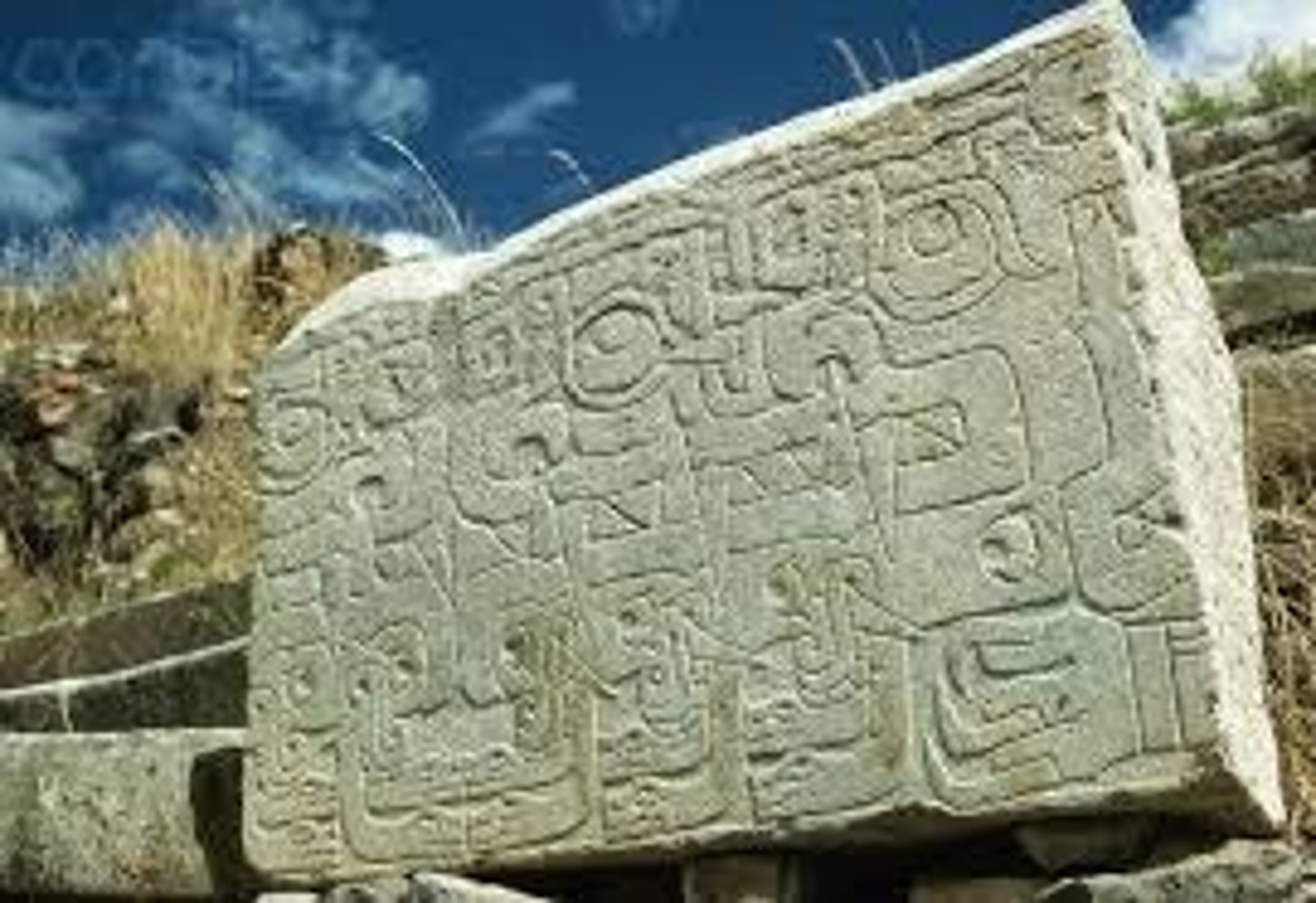
- worn by both sexes under the nose
- held in place by semi-circular section at top
- two snake heads on either end
- makes wearer into supernatural being during ceremonies
Nose ornament
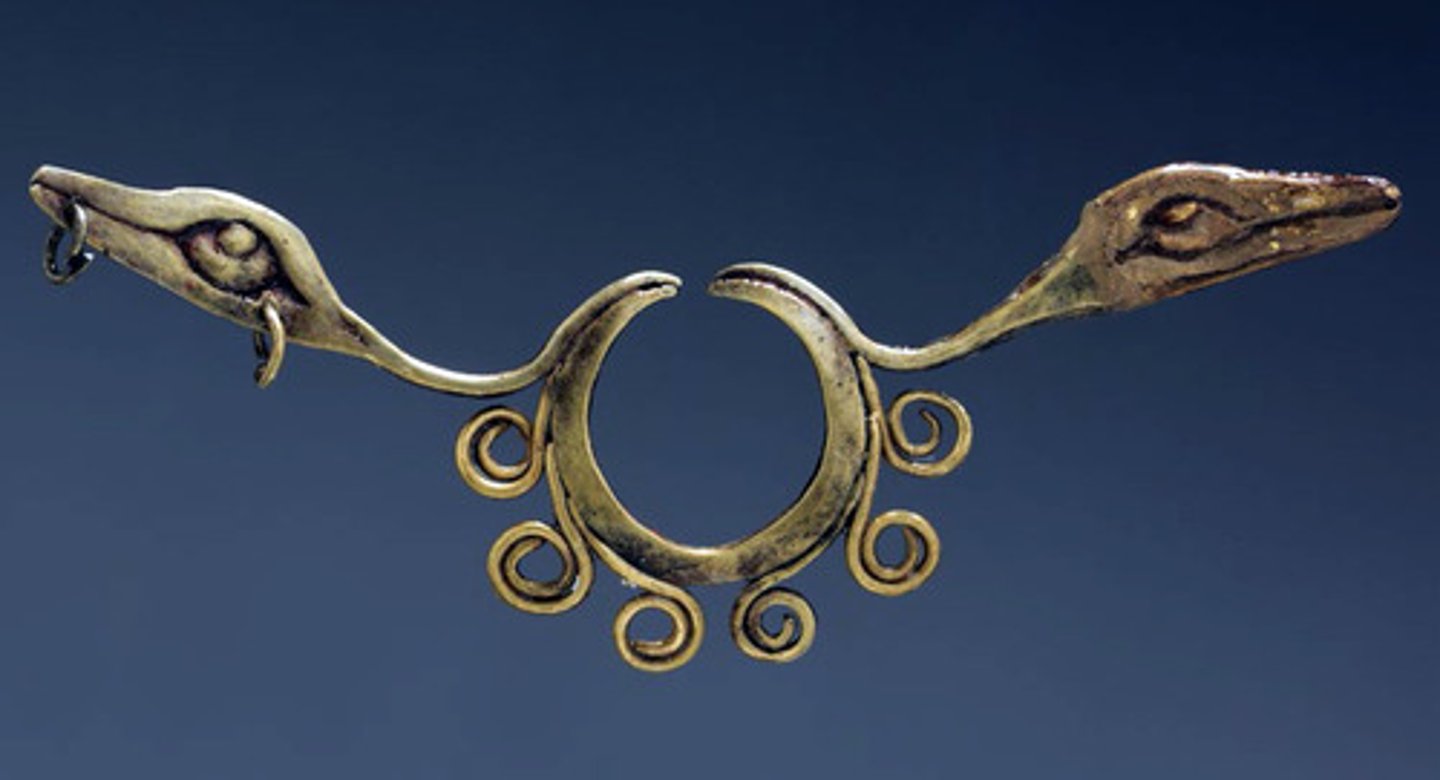
- city set on high terrace; plaza surrounded by important buildings
- flourished c. 300-800 CE
Yaxchilán
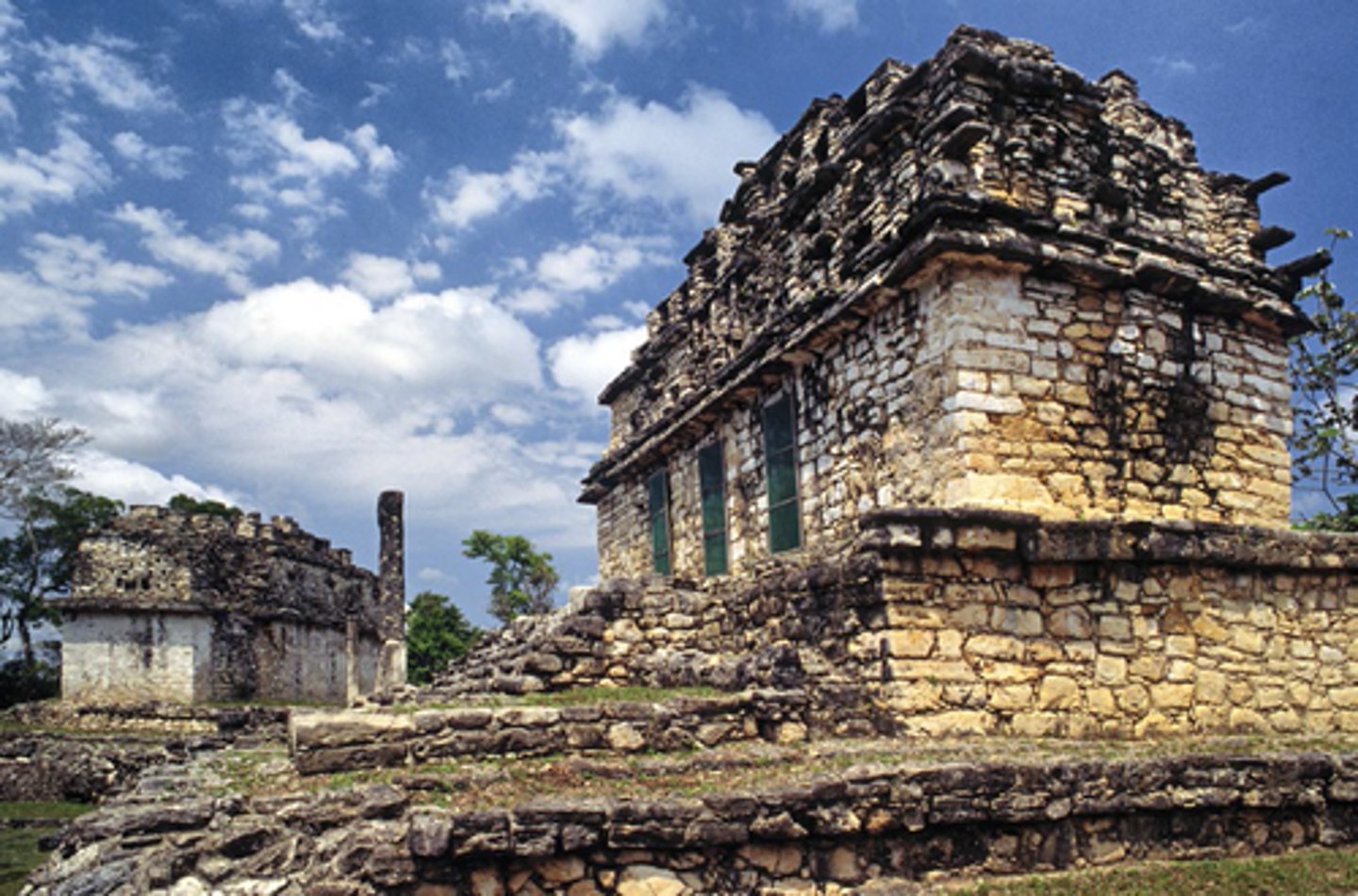
- built by ruler Bird Jaguar IV, or his son who dedicated it to him
- overlooks main plaza
- three doors leading to central room decorated w/ stucco
- roof remains nearly intact, w/ large roof comb
- corbel arch interior
Structure 40, Yaxchilán
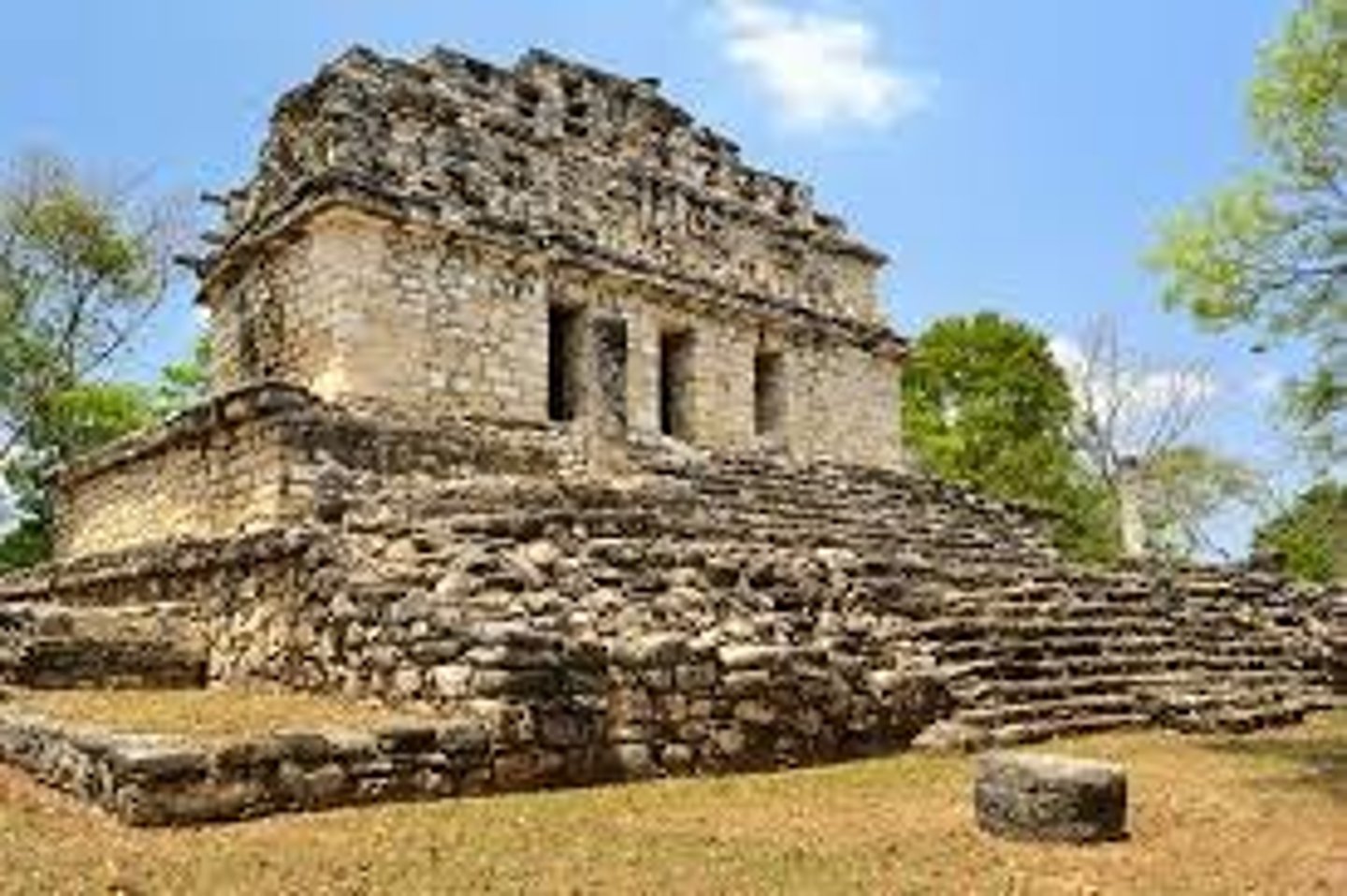
- lintel originally set above central doorway of Structure 23
- building dedicated to Lady Xoc
- Lady Xoc (bottom right) invoking Vision Serpent to commemorate husband's rise to throne
- holds bowl w/ bloodletting ceremonial items: stinging spin and bloodstained paper
- Vision Serpent has two heads: on w/ warrior emerging from mouth, other w/ Tlaloc
- inscription written as mirror image: extremely unusual in Mayan script; uncertain meaning, maybe indicates she had vision from other side of existence, and she is acting as intercessor/shaman
Lintel 25, Structure 23, Yaxchilán
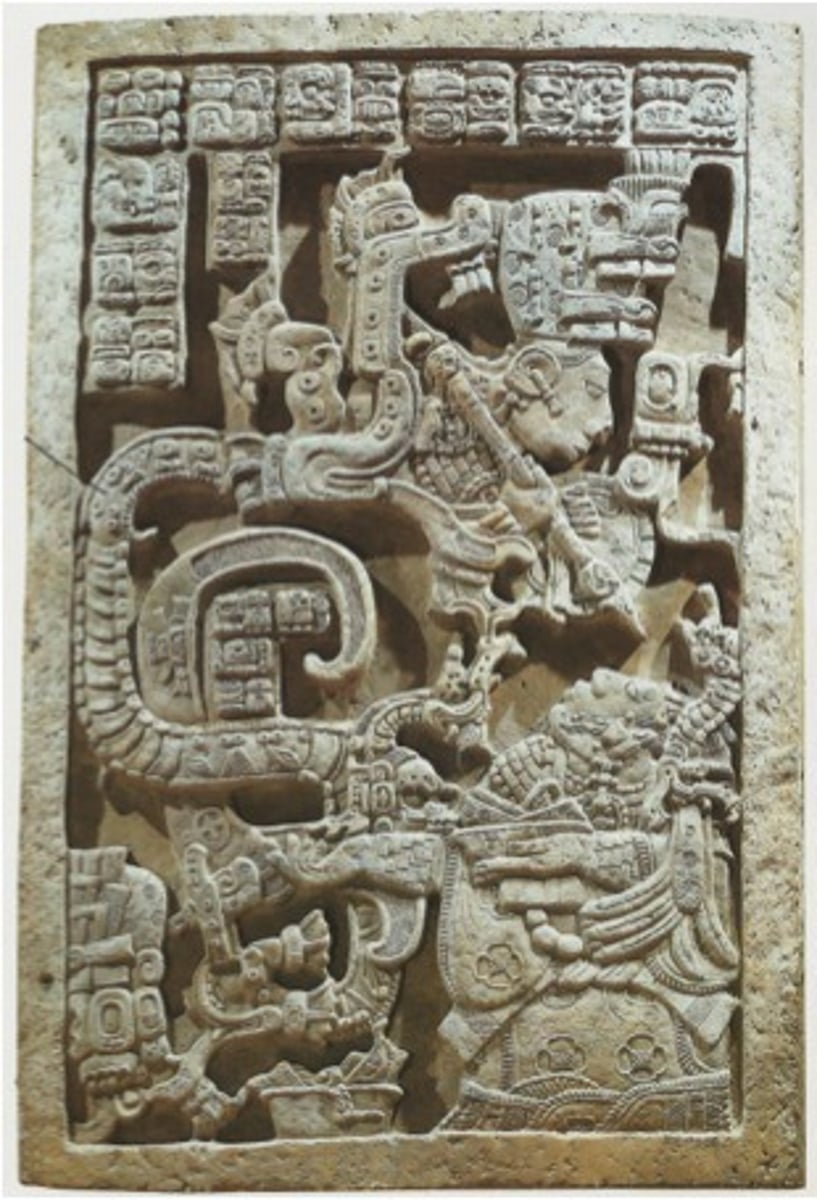
- restored temple structure
- remains of roof comb w/ perforations
- three central doorways lead to large single room
- corbel arch interior
Structure 33, Yaxchilán
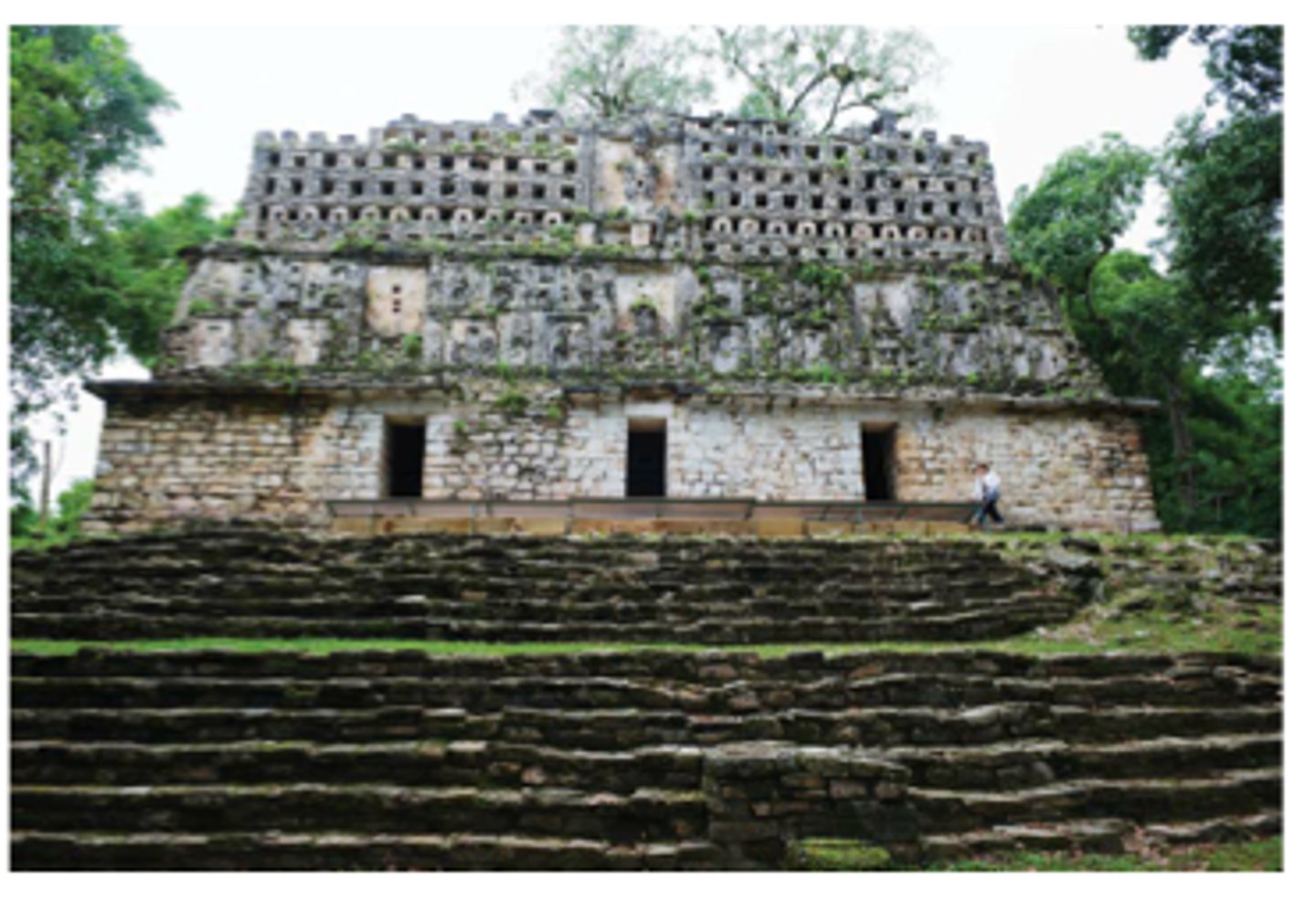
- pueblo built into sides of cliff, housed about 250 people
- clans moved together for mutual support and defence
- top-ledge stores all supplies, cool and dry area out of way, accessible only by ladder
- plaza in front of abode structure; kivas face plaza
- each family received one room in dwelling
- farming done on plateau above pueblo, everything had to be imported into structure, including water
Mesa Verde cliff dwellings
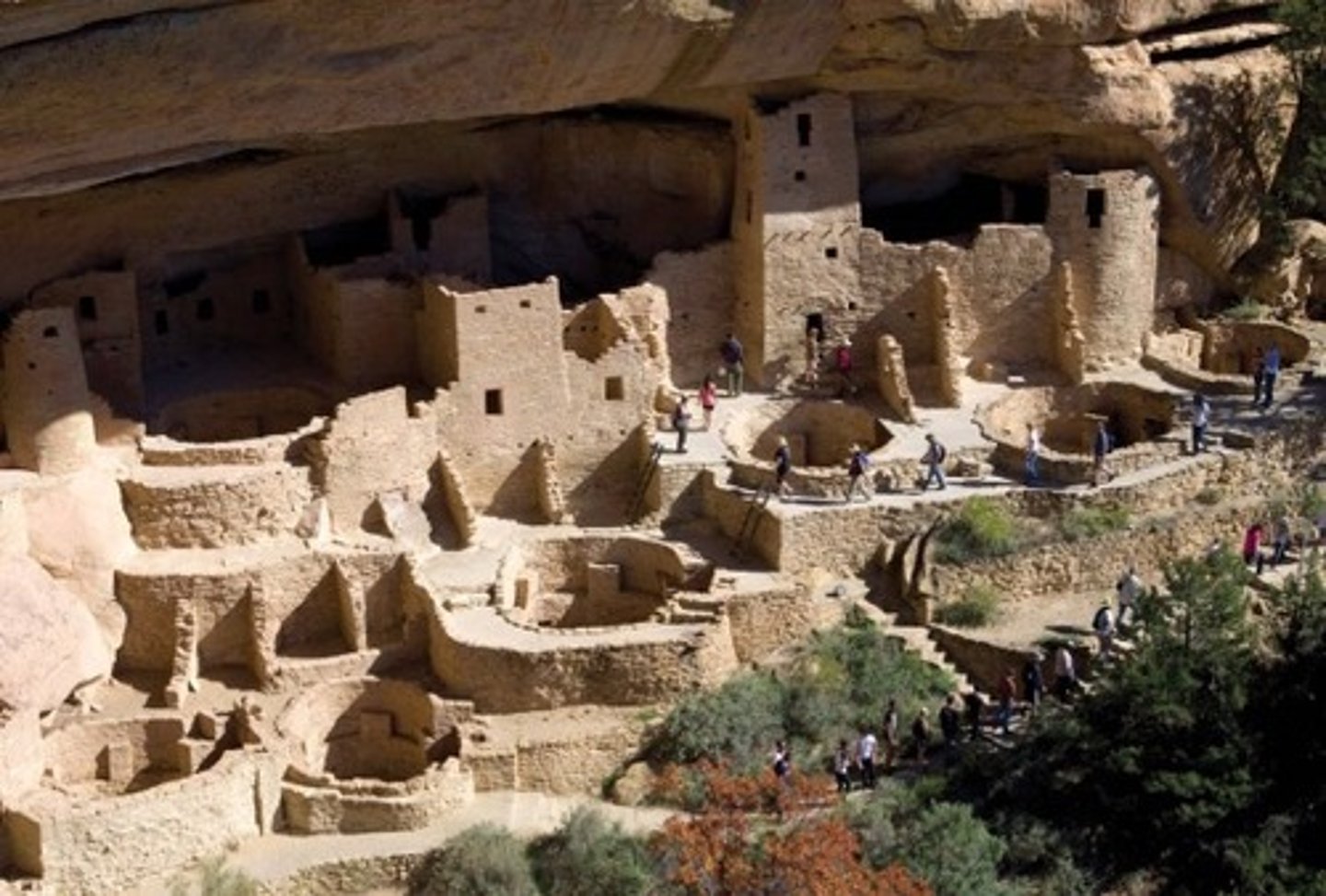
- many mounds enlarged and changed over years, not built in one campaign
- effigy mounds popular in Mississippian culture
- influenced by comets? astrological phenomenon? head pointed to summer solstice sunset?
- rattlesnake as symbol in Mississippian iconography; could this play a role in interpreting this mound?
- snakes associated w/ crop fertility
- no burials/tempes associated w/ this mound
- theory: representation of Halley's Comet in 1066
Great Serpent Mound
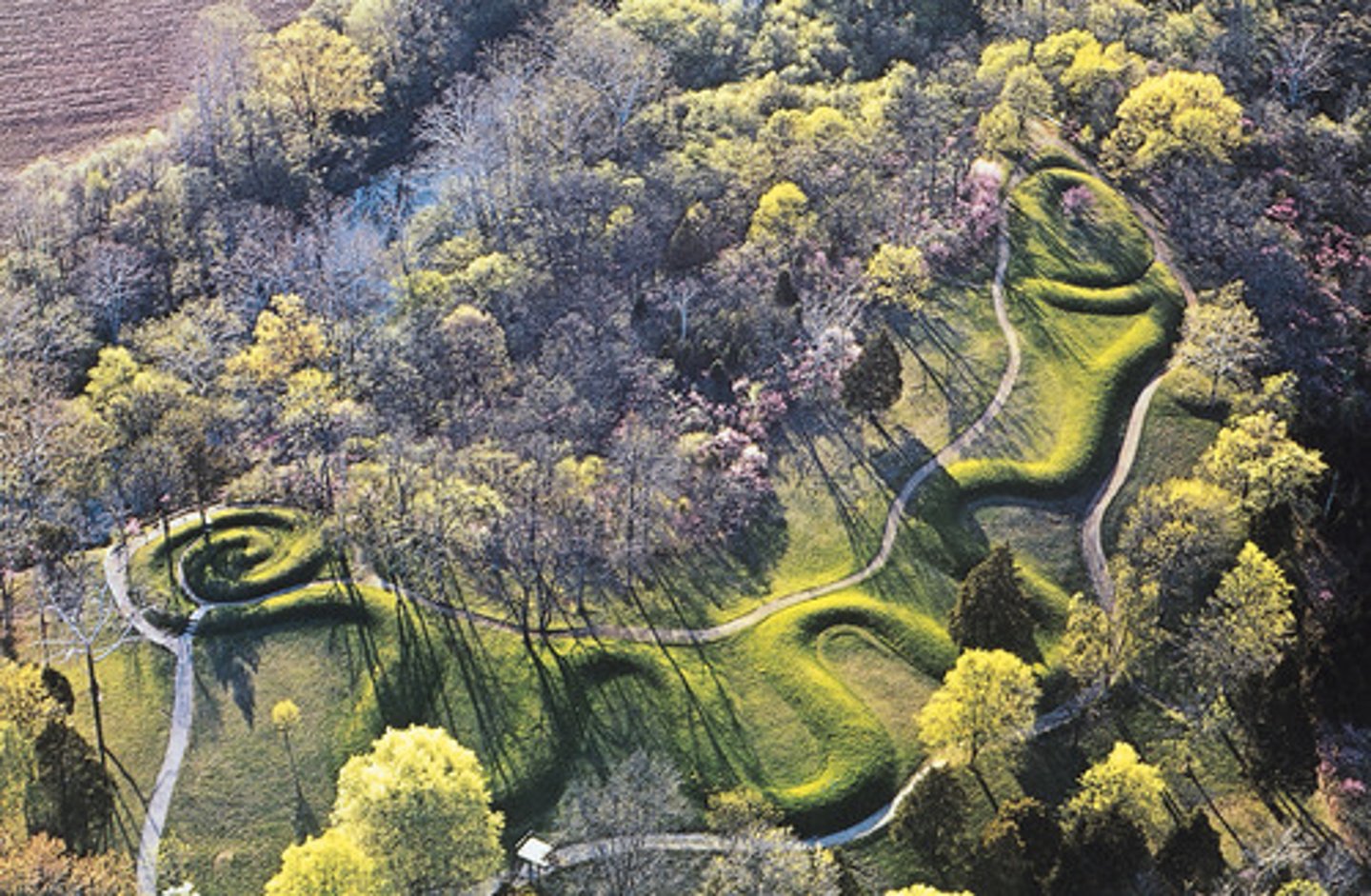
- Tenochtitlan laid out on grid; city seen as center of world
- two temples atop pyramid, each w/ separate staircase
- north: dedicated to Tlaloc
- south: dedicated to Huitzilopochtli
- spring and autumn equinoxes: sun rises between the two
- large braziers put on top where sacred fires burned
- temples begun in 1375; rebuilt six times, destroyed by Spanish in 1520
Templo Mayor (Main Temple)

- "she of the golden bells", because of the bells she wars as earrings
- Aztecs similarly dismembered enemies and threw them down stares of great pyramid to land on disk of Coyolxauhqui, like Coyolxauhqui's fate
- circular relief sculpture
- Coyolxauhqui and her many brothers plotted death of mother, Coatlicue, who became pregnant after tucking a ball of feathers down her bosom; when Coyolxauhqui chopped of Coatlicue's head, child popped out of severed head fully grown, and dismembered Coyolxauhqui, who fell dead at base of shrine
- represents dismembered moon goddess placed at base of twin pyramids of Tenochtitlan
- once brilliantly painted
Coyolxauhqui Stone
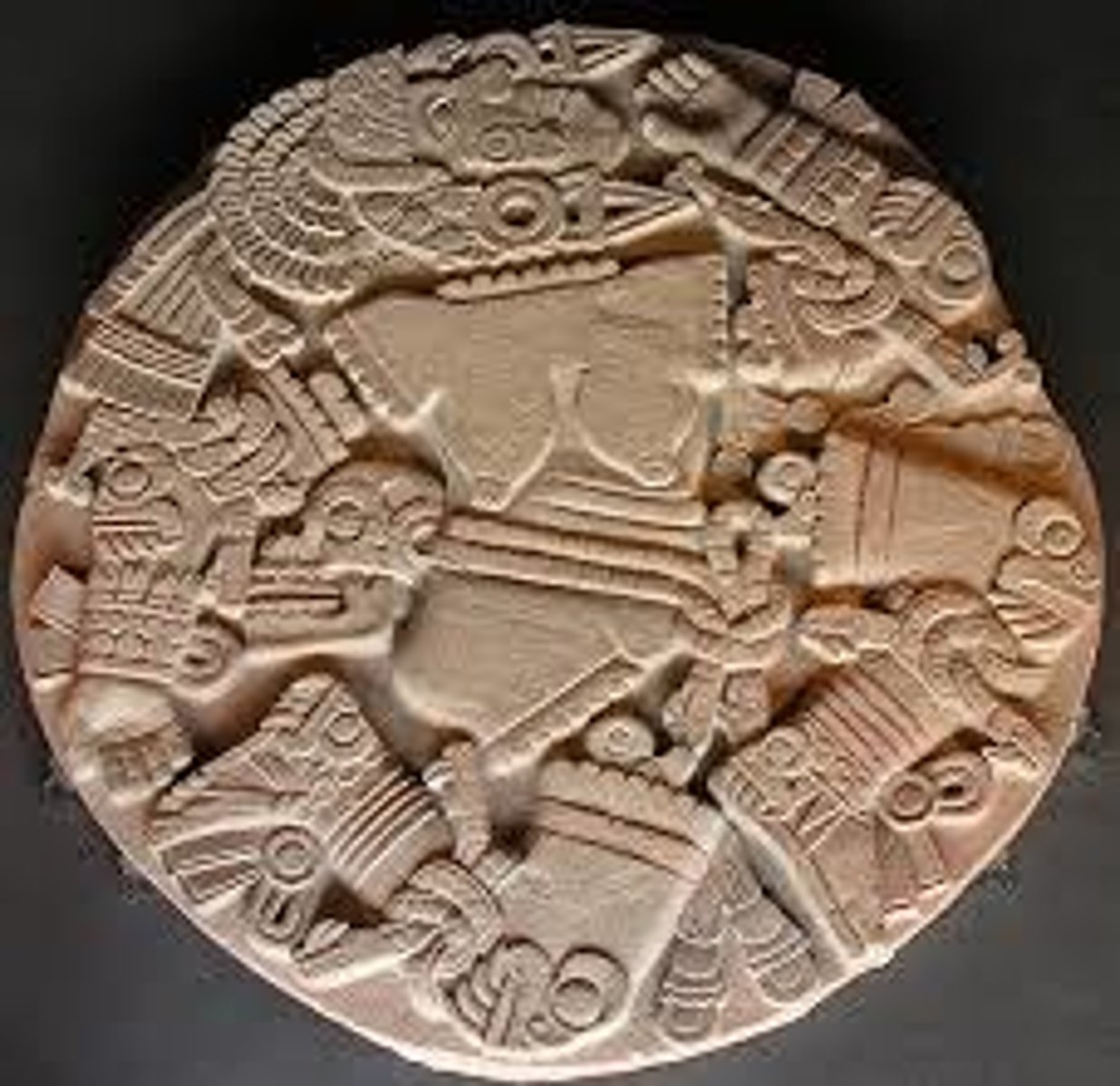
- circular shape reflects cyclic nature of time
- place where rituals took place on certain days
- Aztecs felt they needed to feed Sun god human hearts and blood regularly
- tongue in center coming from god's mouth and sacrificial flint knife used to slash open victims
- altar to murder victims, then threw them down steps of temple to base where Coyolxauhqui Stone rests
Calendar Stone
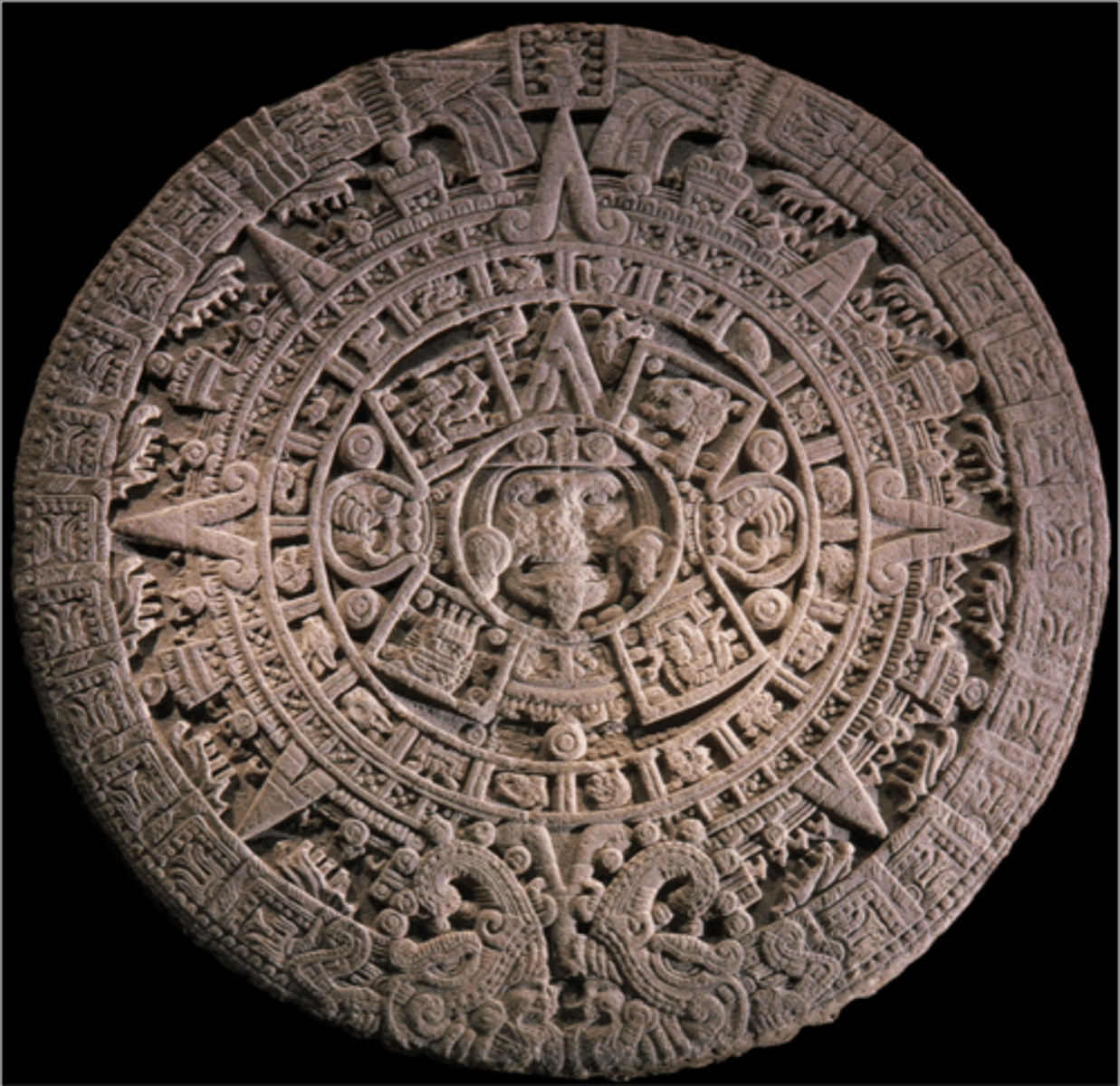
- found on site, actually much older work executed by Olmecs
- Olmec works have characteristics frown on face; pugnacious visage; heavy lidded eyes; headgear suggested
- shows Aztecs collected and embraced artwork from other cultures
Olmec-style mask

- 400 long green feathers are tails of sacred quetzal birds; male birds produce only two such feathers each
- 400 symbolizes eternity
- headdress probably part of collection of artifacts given by Motecuhzoma (Montezuma) to Cortez for Charles V of the Holy Roman Empire
Ruler's feather headdress (probably of Motecuhzoma II)

- maize principal food source in Andes; celebrated by having sculptures fashioned out of sheet metal
- black maize common in Peru; oxidized silver reflects that
- may have been part of garden in which full-sized metal sculptures of maize plants, and other items, were put in place alongside plants
- may have been used to ensure successful harvest
Maize cobs

- historic capital of Inkan empire
- in shape of puma, a royal animal
- modern plaza is in the place where puma's belly would be
- head of a fortress; heart a central square
City of Cusco, plan
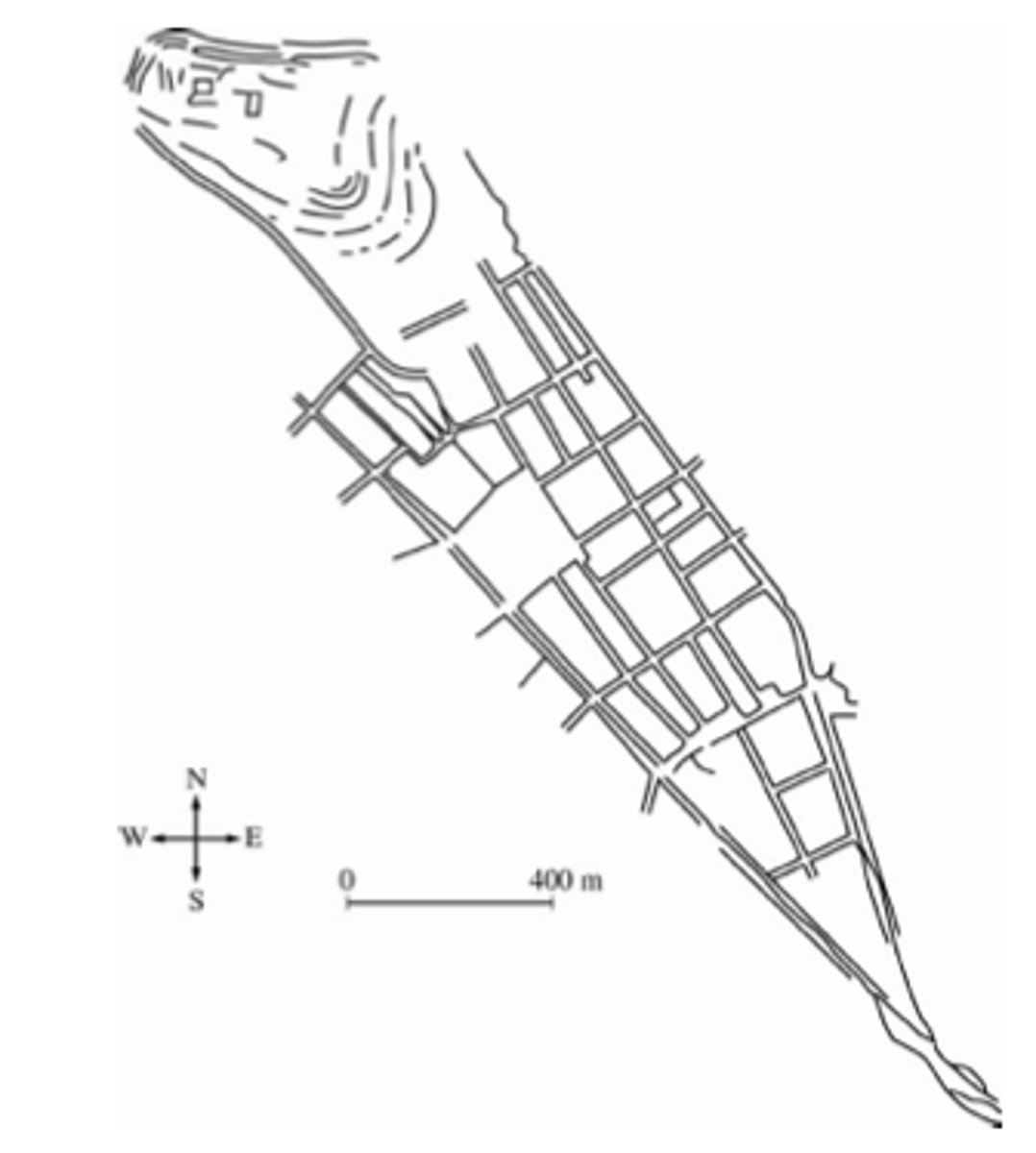
- remains of Inkan Temple of the Sun form base of Santo Domingo convent built on top
- original exterior walls of Temple decorated in gold to symbolize sunshine
- ashlar masonry
- Qorikancha: golden enclosure, once was most important temple in Inkan world
- once was observatory for priests to chart skies
- interior courtyard said to have been entirely covered in gold
- walls taper upward; examples of Inkan trapezoidal architecture
Qorikancha: main temple, church, and convent of Santo Domingo

- complex outside of Cusco, Peru, at head of puma-shaped plan
- ashlar masonry
- ramparts contain stones weighing up to 70 tons, brought from quarry two miles away
Walls at Saqsa Waman
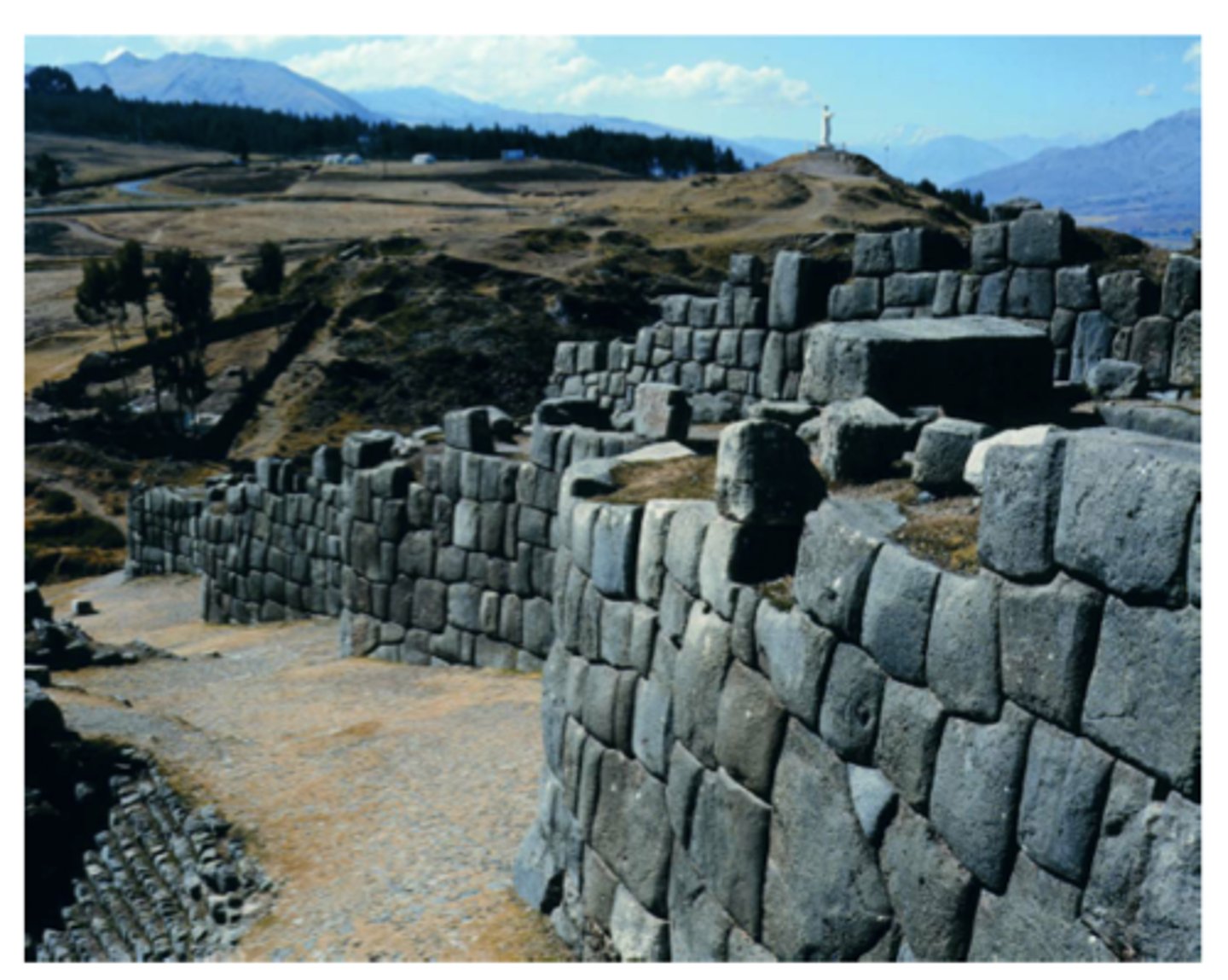
- originally functioned as royal retreat
- estate of 15th century Inkan rulers
- so remote; probably not used for administrative purpose in Inka word
- buildings built of stone w/ perfectly carved rock rendered in precise shapes and grooved together; thatched roofs
- 200 buildings, mostly houses, some temples, palaces, baths, even astronomical observatory; mostly using basic trapezoidal shape
- terrace farming
Machu Picchu
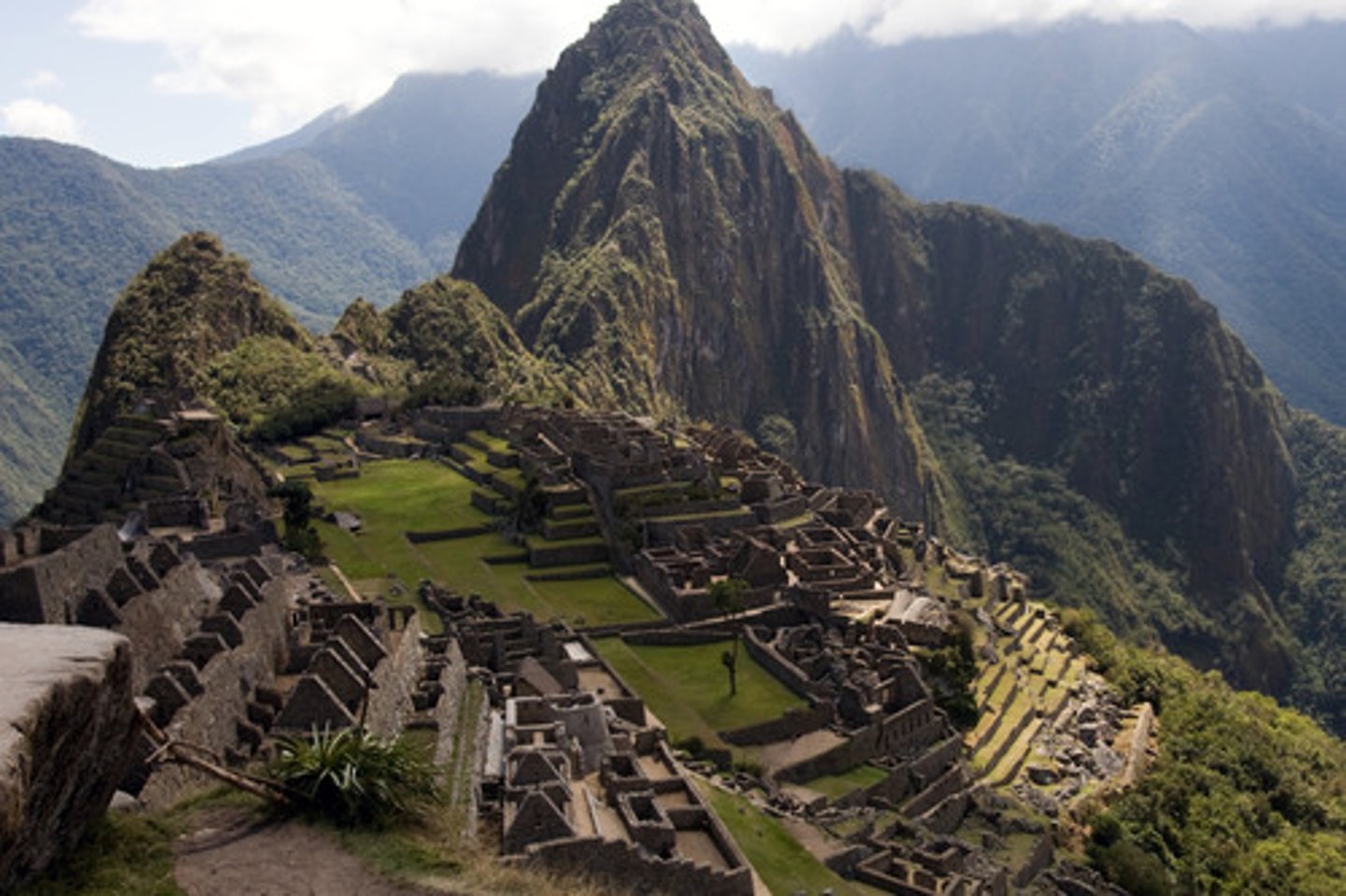
- used to chart sun's movements
- ashlar masonry
Observatory

- "Hitching post of the Sun", aligns w/ sun at spring and autumn equinoxes when sun stands directly over pillar, creating no shadow
- Inkan ceremonies held in concert w/ this event
Intihuatana Stone
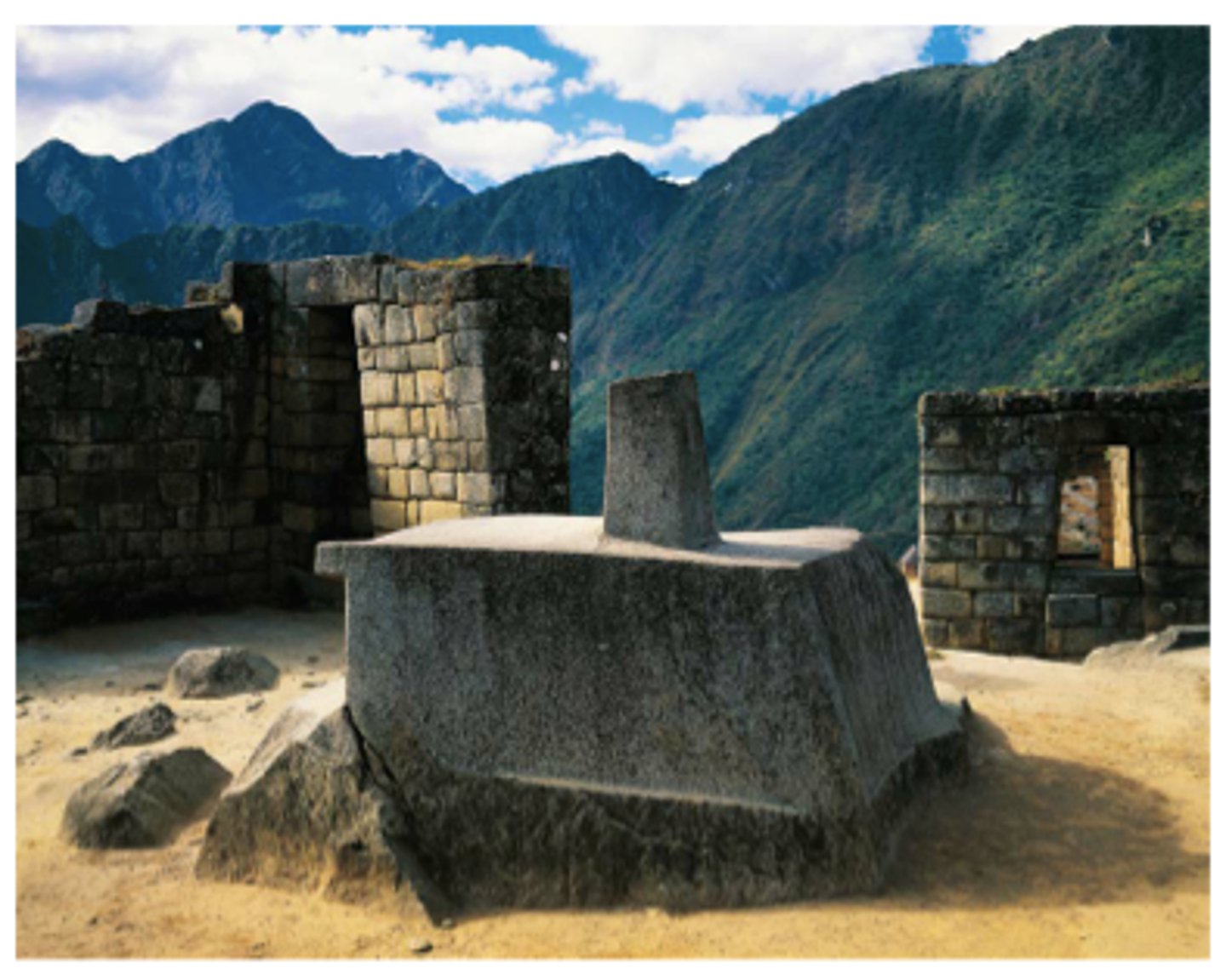
- rectangular shape; slit in center for head, then tunic folded in half and sides sewn for arms
- composition comprised t'oqapu; individual square may be symbolic of individuals/events/places
- contains large number of t'oqapu
- wearing such an elaborate garment would indicate status
- may have been worn by Inkan ruler
- exhibits Inkan preference for abstract designs, standardization of designs, and expression of unity and order
All-T'oqapu tunic
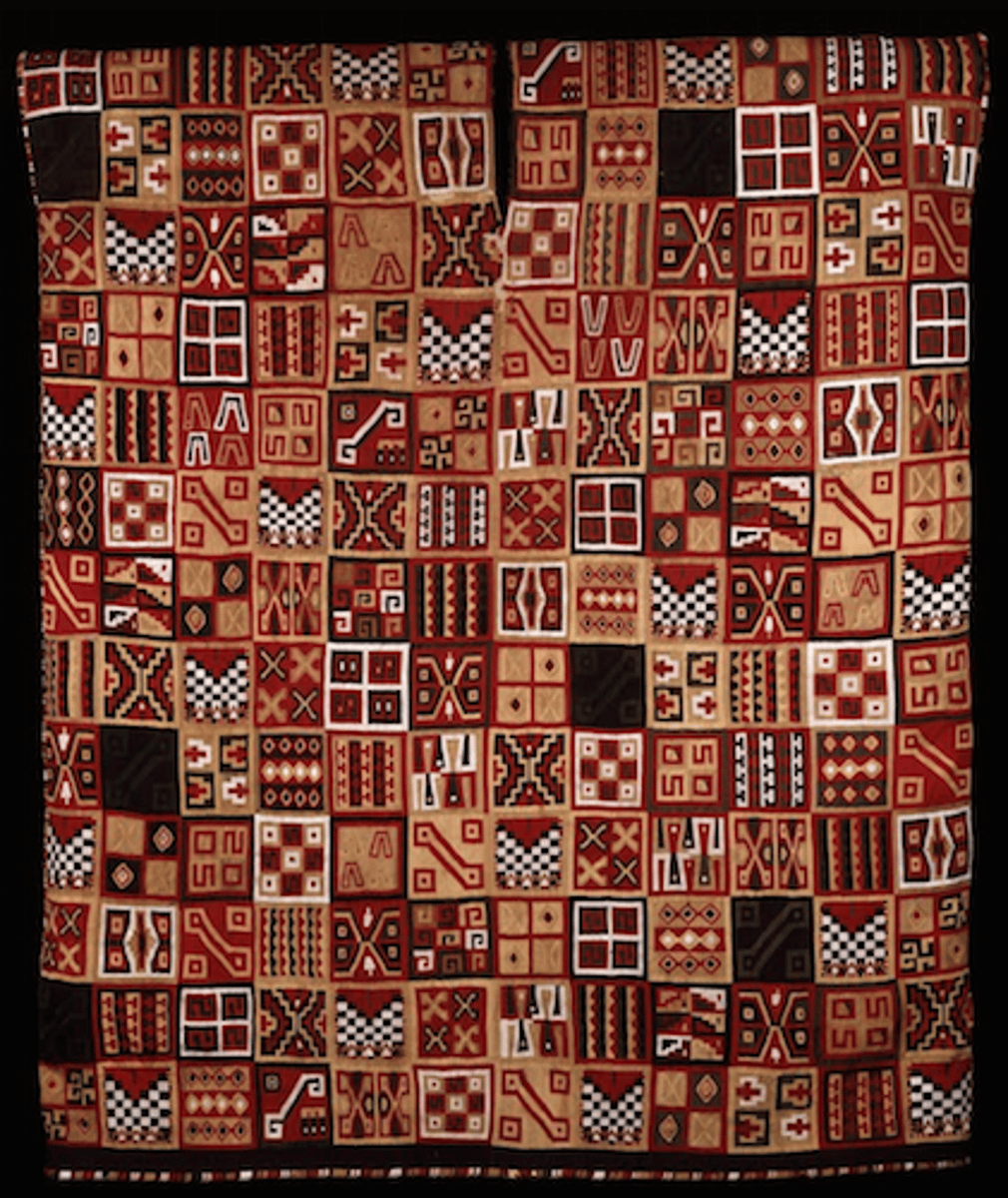
- held at hip level; strap across chest
- constructed of trade cloth: cotton, woo, velvet, or leather
- beadwork not done in Americans before European contact; beads imported from Europe
- meant to be paired with men's ceremonial outfits
- indicated prestige and status
- first used completely for decoration; later had a pouch
- inspired by Europeans' ammo bags
Bandolier bag
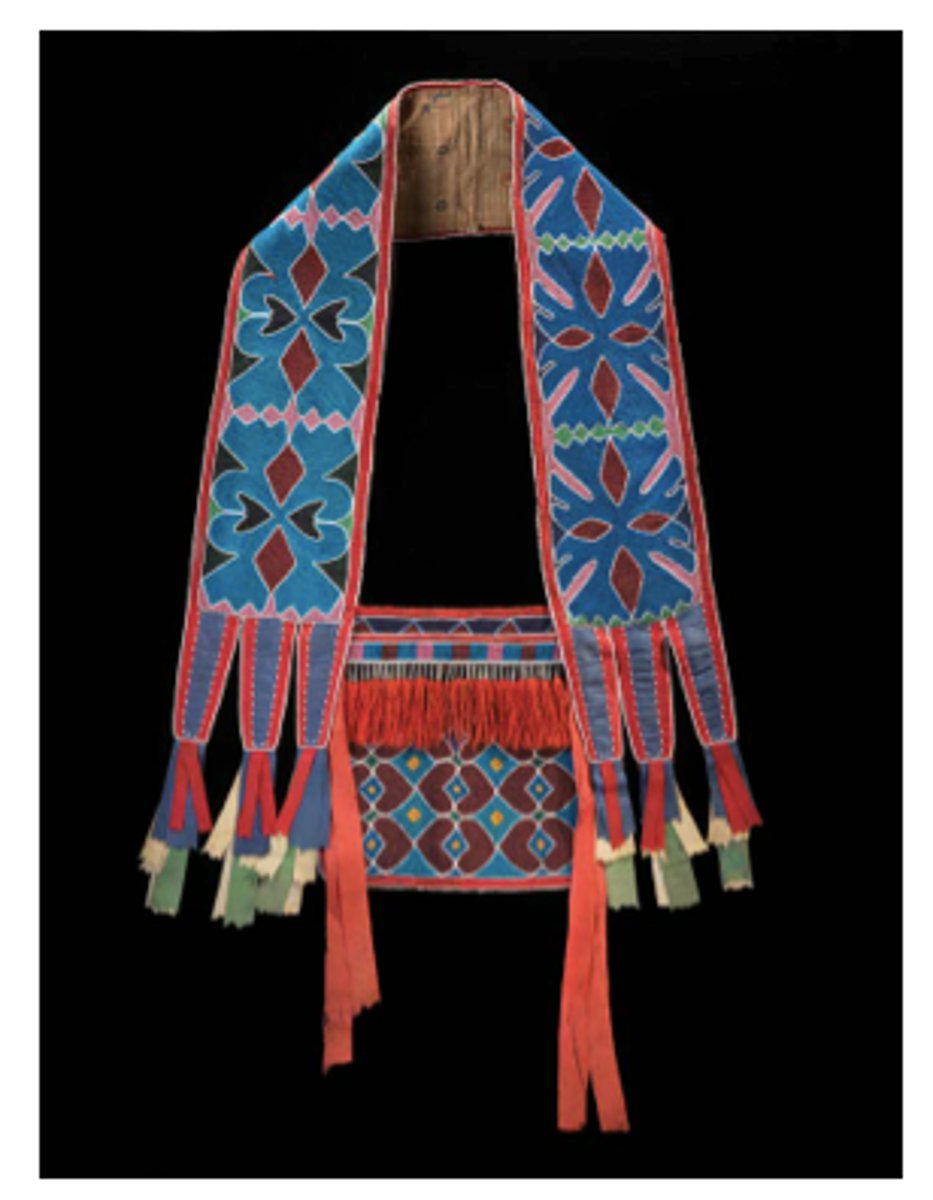
- worn by native people of Pacific Northwest, western Canada, Alaska
- worn over head as part of complete body costume
- during ritual performance, wearer opens and closes transformation mask using strings
- bird exterior opens to reveal human face on interior (w/ birdlike features, ie sharp nose)
- at moment of transformation, performer turns back to audience to conceal action and heighten mystery
Transformation Mask
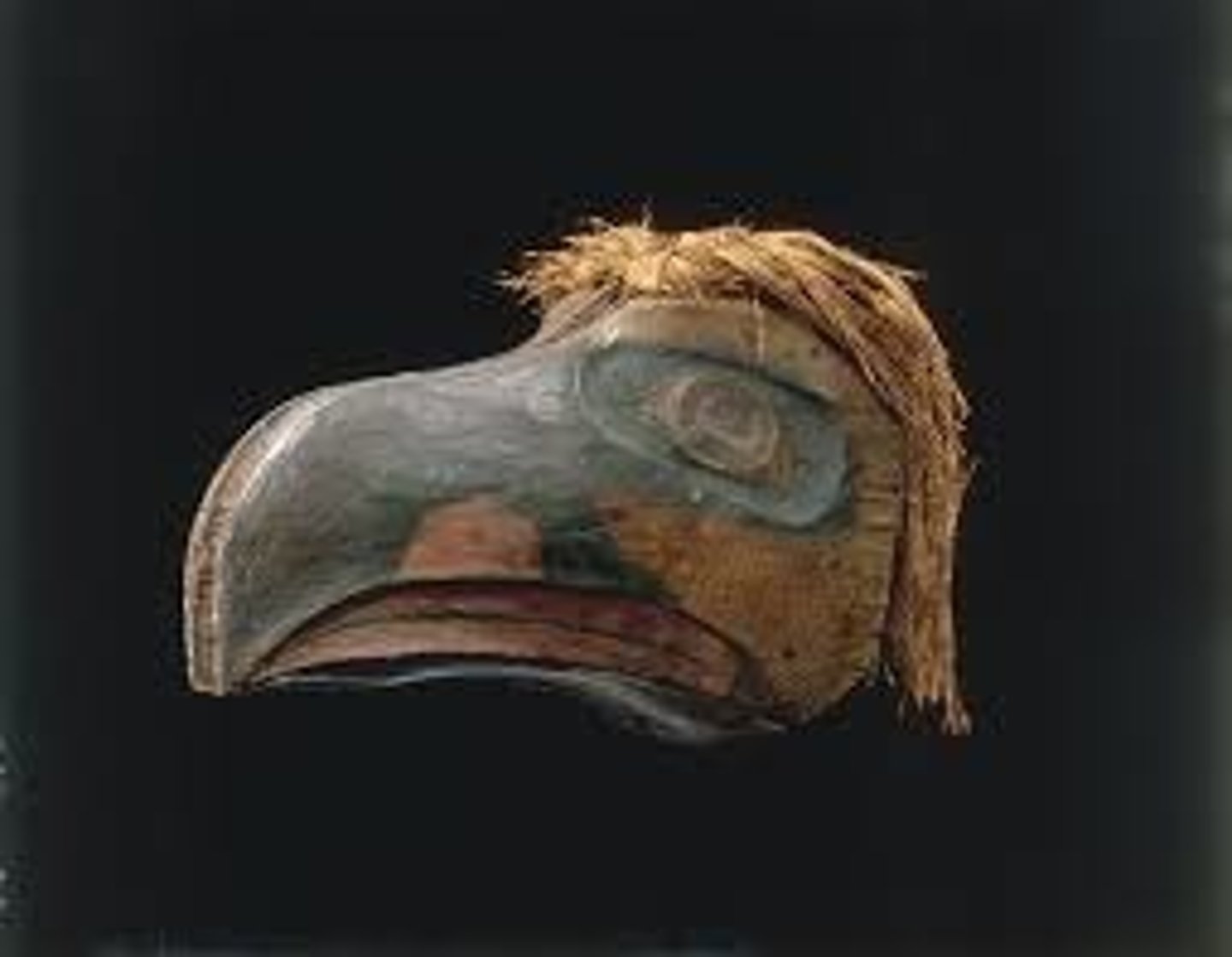
- worn as rober over shoulders of warrior; deeds celebrated on hide
- conveyed biographical details; personal accomplishments; heroism; battles
- men painted hides to narrate event
- eventually painted hides for European and American markets
- depicted traditional aspects of Plans people culture that were nostalgia rather than practical: bison hunt w/ bow and arrow --> nomadic hunting gone, bison nearly extinct
- bison considered to be gifts from Creator
- horses in common use around 1750, liberated Plains people
- Sun Dance conducted around bison head: outlawed by US government; viewed as threat to order
- Sun Dance: men dance; others sing, prepare feast, drum , construct lodge
- teepee
- exterior poles reach spirit world or sky
- fire represents heart
- doorway faces east to meet new day
Painted Elk Hide
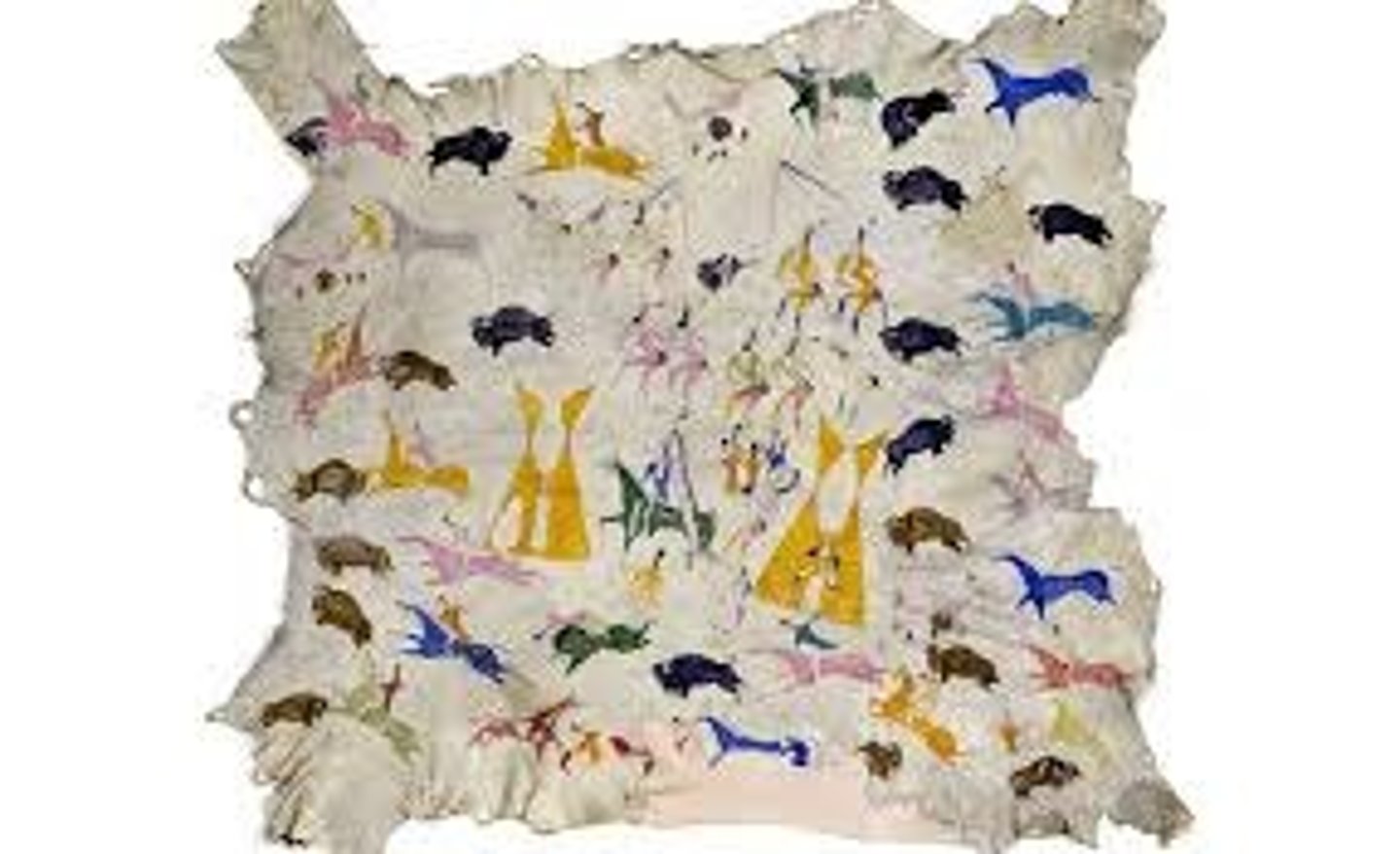
- highly polished surfaces
- contrasts of shiny black and matte black finishes
- comes from 1000 year old tradition of pottery making in Southwest
- at time of production, pueblos in decline; modern life replacing traditional
- work sparked revival in pueblo techniques
- Maria made pots; developed and invented more shapes than traditional pueblos used
- Julian painted pots; uses revival of ancient mythic figures and designs
- exceptional symmetry; walls of even thickness; surfaces free of imperfections
Black-on-black ceramic vessel
